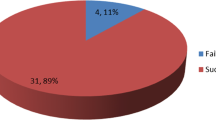Abstract
Objective
The objectives of this study are to report the results of Endonasal Dacryocystorhinostomy (EnDCR) and the role of silicon intubation in EnDCR in Indian population.
Study design
The authors conducted a prospective case series.
Methods
290 patients underwent EnDCR between January 2002 and July 2007 — 240 cases without silicon intubation and 50 cases with silicon intubation. Patients were followed up for an average of 18.6 months in first group and 5.2 months in second group. Outcome was evaluated subjectively and objectively.
Results
In EnDCR without silicon intubation, the procedure was successful in 93.3% of cases. In EnDCR with silicon intubation, the procedure was successful in 96% of cases.
Conclusion
EnDCR is a safe procedure with good success rate and has potential advantages in chronic dacryocystitis cases. The use of silicon intubation in nasolacrimal pathway helps in maintaining the patency of rhinostomy.
Similar content being viewed by others
References
Caldwell GW (1893) Two new operations for obstruction of the nasal duct. N Y Med J 57:581–582
Toti A (1904) Nuovo methodo conservatore di cura radicale delle suppurazioni croniche del sacco lacrimale(Dacriocistor inostomia). Clin Mod Firenze 10:385–387
West and Halle (1914) Intranasalen operation am tranen sack. Arch Laryngolrhinol 28:256–266
Stammbergerger H (1986) Endoscopic endonasal surgery: Concepts in treatment of recurring rhinosinusitis.II. Surgical technique. Otolaryngol Head Neck Surg 94:147–156
Mc Donogh M, Meiring JH (1989) Endoscopic transnasal dacryocystorhinostomy. J Laryngol Otol; 103:585–7
Massaro BM, Gonnesing RS, Harris GJ (1990) Endonasal laser dacryostorhinostomy. A new approach to nasolacrimal duct obstruction. Arach Ophthalmol 108(8):1172–1176
Hartikainen J, Antila J, Varpula M (1998): Prospective randomized comparison of endonasal endoscopic dacryocystorhinostomy and external dacryocystorhinostomy. Laryngoscope 108:1861–1866
Unlu HH, Aslan A, Toprak B, Guler C (2002) Comparsion of surgical outcomes in primary endoscopic dacryocystorhinostomy with and without silicon intubation. Ann Otol Rhinol Laryngol 111:704–709
Heikki S, Reidar G, Jouko H (1994) Endonasal Co2-Na: YAG laser DCR. Acta ophthalmological 72:703–706
Yung MN, Hardman Lea S (2002) Analysis of the results of surgical endoscopic dacryocystorhinostomy: Effect of the level of obstruction. Br J Ophthalmol 86(7):792–794
Mangal S, Vimal J, Gupta SC (2004) Intranasal Endoscopic DCR (END-DCR) in cases of dacryocystitis. Indian Journal of Otolaryngology and Head and Neck surgery 56(3):177–183
Mortimre S, Banhegy GY, Lancaster JL (1999) Endoscopic DCR without silicon stenting. J R Coll Syrg Edinb 44:371–373
Wormald PJ (2002) Powered endoscopic dacryocystorhinostomy 112(1):69–72
Boush GA, Lemke BN, Dortzbach RK (1994) Results of endonasal laser-assisted dacryocystorhinostomy. Ophthalmology 101:955–959
Young MW, Logan BM (1999) The anatomy of the lacrimal bone at the lateral wall of the nose: its signi. cance to the lacrimal surgeon. Clin Otolaryngol 24:262–265
Duke-Elder SS, Macfaul P (1974) System of ophthalmology edited by Duke-Elder. Vol. XII. Part II. London Henry Kimpton
Author information
Authors and Affiliations
Corresponding author
Rights and permissions
About this article
Cite this article
Harugop, A.S., Mudhol, R.S., Rekha, B.K. et al. Endonasal dacryocystorhinostomy: a prospective study. Indian J Otolaryngol Head Neck S 60, 335–340 (2008). https://doi.org/10.1007/s12070-008-0112-z
Published:
Issue Date:
DOI: https://doi.org/10.1007/s12070-008-0112-z




